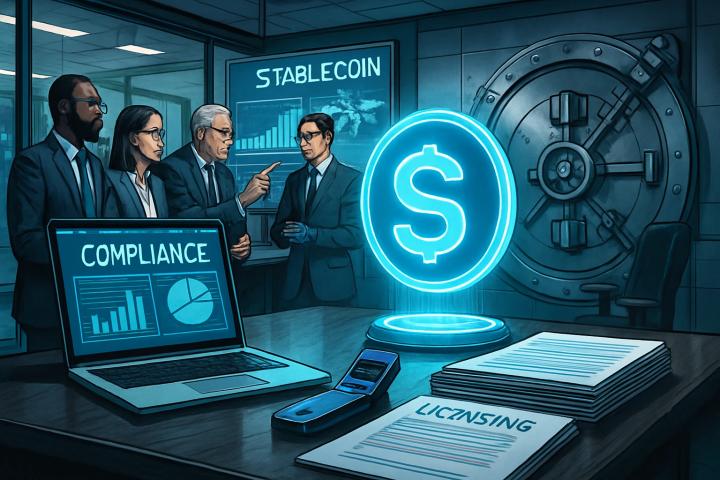When a financial holding company chairman with assets worth trillions compares a global financial instrument valued over $260 billion with daily trading volumes of hundreds of billions to a common transportation ticket, it's not just an inaccurate comment, but a warning bell indicating that Taiwan's leaders are still anchored in the harbors of the previous era when facing the wave of next-generation financial infrastructure; more importantly, this conservative representative and similar officials are still exchanging opinions with financial regulators, potentially influencing the progress of one of Taiwan's most critical financial bills - the Stablecoin Act.
Recently, Mega Financial Holding Company Chairman Mr. Rui-Bin Dong directly stated that stablecoins lack consumer practicality and have no survival space in Taiwan, a statement from an influential figure in the financial industry who frequently communicates with Taiwan's regulatory agencies and central bank, whose influence on regulations cannot be underestimated.
However, this seemingly pragmatic analogy commits a fundamental "category error", akin to commenting on a rocket as if it were a motorcycle. This mindset seems to reflect the current state of Taiwan's virtual asset regulations - appearing to progress while actually standing still - and may become the biggest stumbling block to participating in the global digital economy.
Is EasyCard a Digital Stablecoin? A Fundamental Misunderstanding of Financial Technology
Comparing stablecoins to EasyCard is a basic category error, not just failing to see the forest for the trees, but treating a spaceship ready to explore a new continent like a shuttle boat confined to ports.
EasyCard is essentially a "limited balance payment tool" whose core function is small-scale, proximity-based value transfer, changing only the "act of payment" - from pulling out cash to card sensing. Its usage scenarios are limited to Taiwan, with a centralized system where each transaction requires clearing through EasyCard Company and partner banks. Its card issuer's profit model involves using the average balance of transportation cards multiplied by customer numbers to generate short-term investment or financial arbitrage.
Its risk lies in the issuing institution's credit, so regulation focuses on ensuring "stored value" safety, such as requiring bank trust and dedicated funds. By 2025, approximately 194 million electronic stored-value cards will circulate in Taiwan, with around 13.8 million active cards - a mature and massive local payment ecosystem, but that's where its comparison with stablecoins ends.
Stablecoins are fundamentally not a "limited balance payment tool", but a "programmable financial infrastructure". Their birth aims to create a low-volatility, high-liquidity "value medium" on the global blockchain network. They don't change the payment action, but the "essence and flow of value".
The liquidity of stablecoins is point-to-point, 7x24 hours, and cross-border, bypassing the traditional banking clearing network (such as SWIFT). The more core difference lies in "programmability" - developers can build various automated financial applications on top of stablecoins, such as real-time cross-border salary settlement, automatic supply chain financial payments, automatic insurance claims, seamless trading on decentralized exchanges (DEX), automatic arbitrage implementation, and so on.
Businesses in need of liquidity obtain stablecoins through stablecoin issuers, and stablecoins achieve large-scale reserve guarantees and profitability by arbitraging short-term Treasury bills and short-term commodities, which is completely different from the profit model of small-value stored-value card operators, differing entirely in customer and cash flow generation, as well as risks.
According to data, the global stablecoin market capitalization has exceeded $267 billion in 2025, with daily on-chain real payment volumes reaching $2-3 billion. Payment giants like Visa, Mastercard, and PayPal are all deploying stablecoin settlement networks. This is a species completely different from stored-value cards in scale, level, and application potential.
Chairman Rui-Bin's assessment of stablecoins as "non-interest-bearing", "less convenient than credit cards", and "unlikely to be popular in Taiwan" is like a self-proclaimed military expert commenting on an F-35 fighter jet as having "no cup holder" and "small rear space", completely misplacing the point of comparison.
His assumption about whether Taiwanese consumers will use it is also an arrogance and alienation born from long-term ivory tower living. In fact, USDT has long been the mainstream of underground transactions in Taiwan, already integrated into public life. However, Taiwan's regulations later prohibited private USDT trading to combat fraud, with no legal channels for offline transactions, which may involve constitutional issues pending legal system research, but it shows how disconnected bureaucratic law-making is from public life.
What he fails to see is how Taiwan's industry and economy will be disrupted by this new global financial underlying protocol. Just because you don't use it or think Taiwan doesn't need it doesn't mean foreign investors or tourists coming to Taiwan won't use it. When China advances through Hong Kong, South Korea's Lee Jae-myung, and Trump accelerates US stablecoin legislation, such "Taiwan doesn't need it" and "stored-value cards are better" arguments are just old, show-off theories fundamentally unable to align with the world.
Borders Disappear in the Stablecoin World: Taiwan Losing "Monetary Discourse Power"
Chairman Rui-Bin's second blind spot is his extremely narrow "domestic consumer" perspective. While precisely analyzing the interest conflicts between issuers and users (issuers can earn reserve asset interest), he completely overlooks the global power shift stablecoins are triggering: from "sovereign currency" to a "super-sovereign monetary network" led by tech companies or decentralized protocols.
Ironically, Rui-Bin himself mentioned that China and Hong Kong are actively developing stablecoins to compete for "monetary discourse power". This observation might be correct, but he fails to reflect on Taiwan's position in this game. As global digital trade, cross-border e-commerce, and remote work become increasingly common, businesses and individuals seek the lowest-friction, highest-efficiency settlement tools.
If a Taiwanese software company has employees or clients across Europe, America, and Southeast Asia, what it needs most is a channel to receive US dollars or Euros instantly and at low cost. This channel won't be traditional, expensive, time-consuming wire transfers or stored-value cards, but most likely USDC or EURC stablecoins based on Ethereum or Solana networks.
When such transaction models become the norm, a new form of "Digital Dollarization" will quietly occur. Taiwanese companies' balance sheets will increasingly show US dollar stablecoins instead of New Taiwan dollar deposits. The circulation and influence of New Taiwan dollars will be compressed to domestic retail and salary payments, gradually losing its role in international trade. Power is silently flowing from Taiwan's central bank to the US Circle company issuing USDC and the monetary policies of the US Federal Reserve behind it.
When the whole world is building its digital currency highways, if we're still debating how pedestrian-friendly this road is domestically and choose to remain closed, there's only one outcome: in the future, we'll only be able to pay expensive tolls on highways built by others and follow rules set by others. What we'll lose is not just financial innovation opportunities, but our national economic sovereignty.
Cutting Qing Dynasty Officials with a Ming Dynasty Sword: Why Regulating Stablecoins with a Stored-Value Card Perspective is Disastrous
Most worryingly, this "stored-value card mindset" has substantially influenced Taiwan's regulatory direction. The current draft of Taiwan's "Virtual Asset Management Regulations" still fundamentally borrows from the EU's MiCa regulations' "prevention" and "regulatory registration", essentially preventing traditional financial vulnerabilities like stored value misappropriation and money laundering, approaching blockchain with an attitude that it's a "foreign product" to be contained and blocked.
Stored-value card risks are relatively simple: company bankruptcy means losing stored value. This is a single, controllable centralized institutional risk that can be effectively regulated through bank trusts and periodic audits. However, the banking risks brought by stablecoin popularization are in an entirely new dimension, such as: smart contract code risk: code vulnerabilities leading to asset theft by hackers; de-pegging risk: algorithmic stablecoin mechanisms failing or collateral asset values collapsing, causing price deviation from the anchored currency; global bank run risk: global holders simultaneously selling on decentralized exchanges during market panic, triggering liquidity crises.
These risks are cross-border, decentralized, and calculated in seconds. Attempting to address them with a "single country, closed, specific-purpose" stored-value card management logic is like trying to block a tsunami with a brick wall. Such statements and regulatory directions not only fail to effectively manage real risks but also transmit the current industry's rigid thinking. When such thoughts and representatives continuously enter virtual asset legislation meetings, they undoubtedly strangle all innovation possibilities and cut off Taiwan's potential bridges to future industry customer acquisition.
If a Taiwanese development team wants to create a programmable, automated financial tool for the global market, such as a protocol that can automatically settle real estate and credit in DeFi lending agreements, they need a value medium that can seamlessly integrate with the global on-chain ecosystem; whereas a "Taiwanese stablecoin" that is merely a "point system" managed like an EasyCard, closed, non-programmable, server-centralized, and limited to domestic use, is utterly useless for these financial entrepreneurs and emerging business opportunities.
Ultimately, our laws are not protecting consumers, but forcing the next generation of digital economic builders to relocate their companies and talents to Singapore, Hong Kong, or Dubai. Taiwan's regulation appears rigorous but is actually trapped in a "managing nothing" dilemma, neither addressing genuine risks nor welcoming opportunities.
Conclusion: Abandon Defensive Thinking and Confront Future Challenges
Chairman Rui-Bin Dong's remarks are worth serious consideration because they perfectly expose the deeply rooted "defensive mindset" of Taiwan's financial establishment. When facing disruptive innovation, their first reaction is not to understand its operational logic and potential opportunities, but to quickly categorize it into a familiar old framework, then exclude it intellectually with reasons like "impractical" or "high risk", thereby maintaining the comfort of existing order.
This is an ongoing "cognitive warfare" between forces representing the past and the digital economy of the future. If we let the former define the rules, Taiwan will be completely absent from the reshaping of the global financial landscape.
What Taiwan needs is not more "professors" attending financial conferences or playing key roles in the Financial Supervisory Commission's closed-door virtual asset meetings, using expert roles to remind government officials about the impracticalities and regulatory risks of new technologies, and suggesting that the FSC and central bank apply existing frameworks. Instead, Taiwan needs strategic thinkers who understand the global stablecoin landscape, who can boldly innovate and catch up with international trends in the face of conservative opposition.
Taiwan must clearly recognize: stablecoins are absolutely not EasyCards, but the next-generation financial infrastructure and a new settlement layer tied to sovereign currencies; this competition is not just about commercial interests, but an extension of national sovereignty; regulatory goals should not only be blocking yesterday's risks but paving the way for tomorrow's innovations.
The choice is in our hands. We can continue driving an old car using the rearview mirror, immersed in past glories of Taiwan's payment convenience; or we can lift our heads, directly face the new global track paved by blockchain, stablecoins, and programmable contracts, and courageously step on the accelerator. This is not about right or wrong, but about survival.





